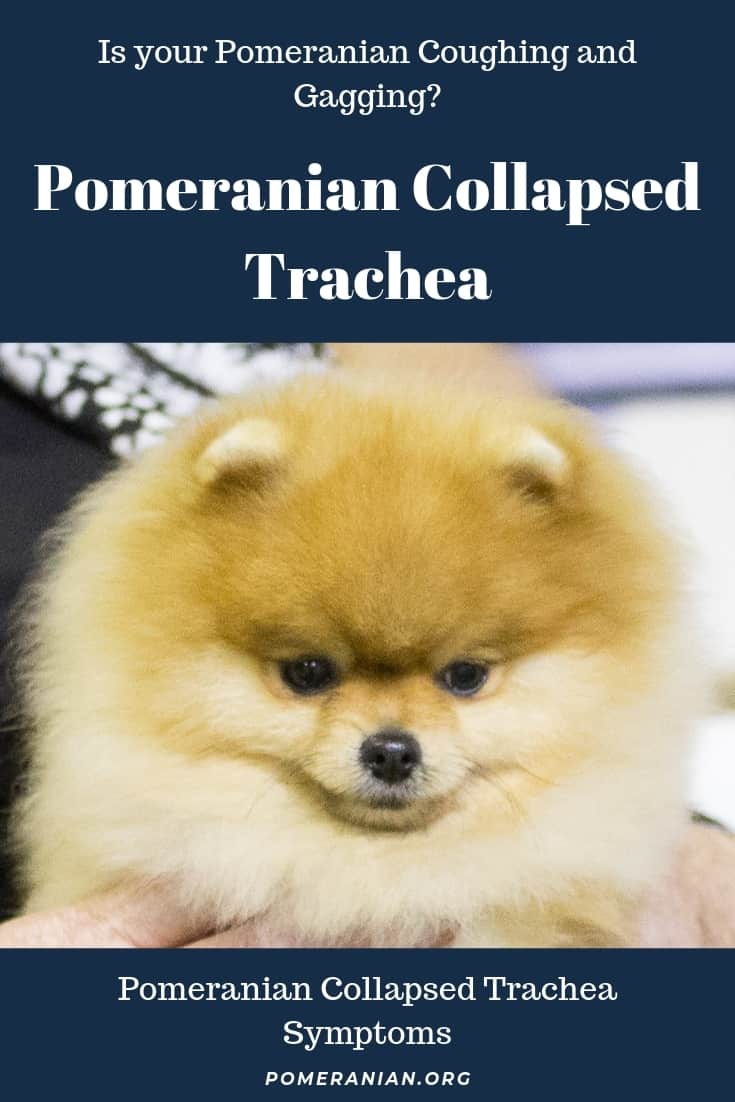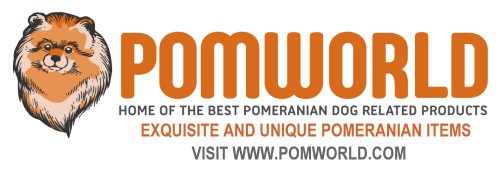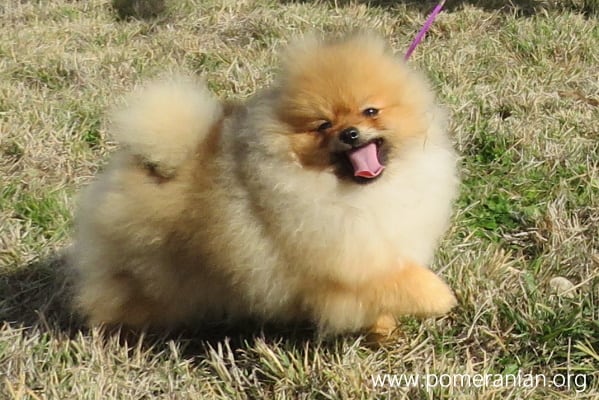Last Updated on 29/11/2023 by Dochlaggie. Post first published on November 16, 2022.
This article about Pomeranian collapsed trachea issues has been written in consultation with our resident Veterinary Doctor: Dr. Muqeet Mushtaq DVM, MSc.
Pomeranian breed health problems include collapsed trachea in Pomeranians. Pomeranian trachea issues are a serious problem and also can be encountered in many small-breed dogs.
This is where the cartilage rings around the trachea (windpipe) are weakened and collapse inwards, obstructing the windpipe and making the dog cough.
There’s no single recognized cause of Pomeranian trachea problems, but it’s believed many factors contribute to this issue. The trachea is a circular tube that’s rigid and goes from the throat to the chest.
If it does collapse, it’s from top to bottom, not side to side. The chest part is usually the collapsed area but any part of the tube can collapse and cause problems.
The most likely cause of Pomeranian tracheal collapse is the abnormal synthesis of parts of the cartilage that are found in the trachea. This is a structural part of his trachea. Pomeranian breathing problems with this disease include unpleasant coughing spasms as a result because the trachea flattens out and blocks the airflow to and from the dog’s lungs.
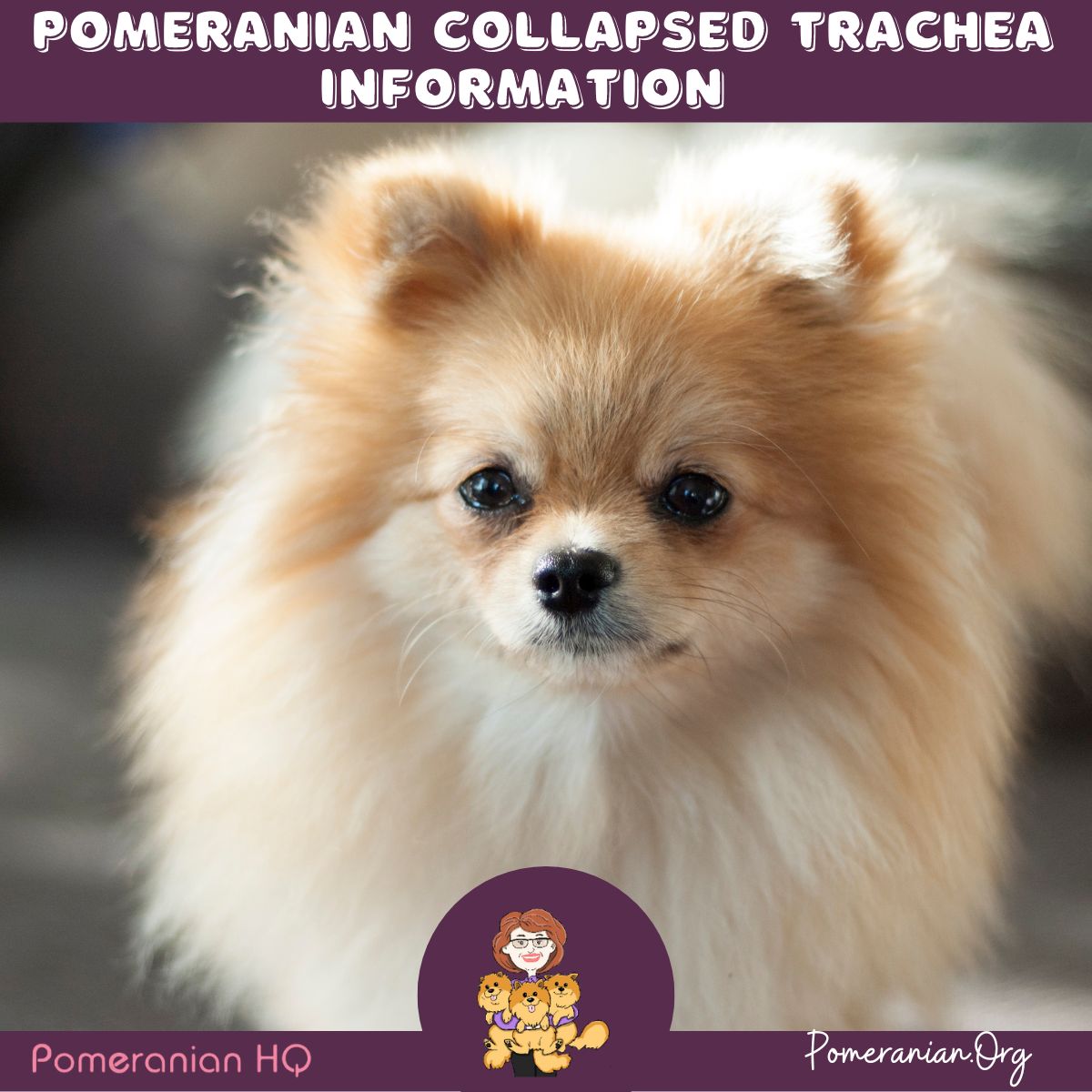
Causes of Pomeranian Trachea Problems Include:
- Congenital defects.
- Tumors that externally compress the trachea.
- Trauma.
- Chronic airway disease.
There are a number of other medical problems that can cause your dog to cough, which contributes to the collapsing trachea. They include:
- Obesity.
- Extremely soft palate.
- Pneumonia.
- Chronic bronchitis.
- Allergic bronchitis.
- Respiratory irritation from too much dust or cigarette smoke.
- Congestive heart failure.
- Too much excitement.
- Humidity and/or hot weather.
- Drinking and eating.
After the trachea has collapsed, coughing will cause more coughing and irritate and inflame your dog’s throat. Then mucous and other secretions will further block the air passage. Both genders can face this problem.
It’s generally only a health problem found in toy breeds and the most common breed to suffer from this problem is the Yorkshire Terrier. However, Poodles, Chihuahuas, Pomeranians, and Maltese are also in a higher risk category. Although dogs can have this disease at any age, it’s most common when they’re six or seven years of age.
Pomeranian Collapsed Trachea Symptoms
- Respiratory discomfort. The dog makes a wheezing sound when trying to breathe.
- Pomeranian coughing and gagging.
- Pomeranian coughing a lot.
- Unable to handle exercise.
- Pomeranian honking cough, Which is a dry cough that many call a “goose honk ” or the Pomeranian goose cough.
- Labored breathing.
- Cyanosis (gums have a bluish tinge).
Pomeranian Health Problems Collapsing Trachea Diagnosis Methods:
Palpation of your dog’s trachea. If the vet applies light pressure to the trachea and you hear the “goose honk,” it’s an indicator of a collapsed trachea.
X-rays. X-rays can be taken during exhalation and inhalation to identify a collapsed trachea as well as lung and/or heart problems. When the dog inhales, the top part of the trachea collapses.
When he exhales, the lungs end collapses. Fluoroscopy. X-rays won’t always help. This test is a continuous x-ray and shows what happens while the dog is coughing or breathing.
Tracheobronchoscopy. If the vet still doesn’t have sufficient information, this test is used. A small camera (and light) is inserted into the dog’s trachea. This helps the vet see what and where the actual problem is so that further steps can be taken.
Pomeranian Collapsed Trachea Treatment at Home and Prevention
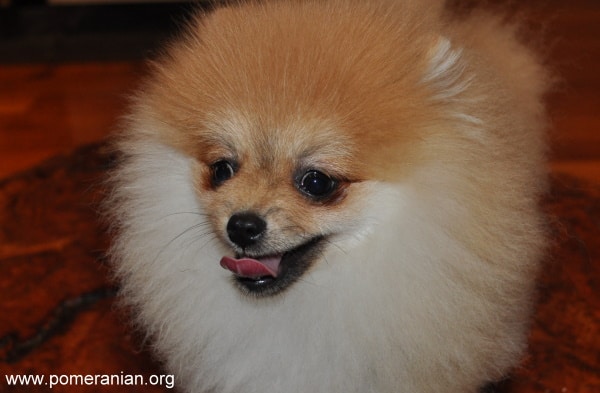
Give your Pomeranian dog whatever medicines the vet has prescribed. Make sure you use the cough suppressants because if the cough is controlled, other aspects of the problem can settle to some degree. Remove his collar and just use a harness to avoid anything tight around his neck.
Collapsed Trachea in Pomeranians Remedy
Help prevent Pomeranian breathing issues by keeping the home clean and free from dust, smoke and other irritants. If he can handle it, take him for regular walks. If not, then it’s more important to give him a healthy diet to help him lose weight and improve overall symptoms.
Treatment for Collapsed Trachea in Pomeranian at Vet Include:
Immediate methods include:
- Bronchodilator like theophylline or terbutaline etc., allow more oxygen to reach the bloodstream.
- Cough suppressants.
- Fast-acting steroids.
- Oxygen.
- Sedation.
Long Term Pomeranian Collapsed Trachea Treatment Include:
- Cough suppressants.
- Steroids.
- Airway dilators.
- Reducing your dog’s weight.
- Surgically reconstructing the trachea.
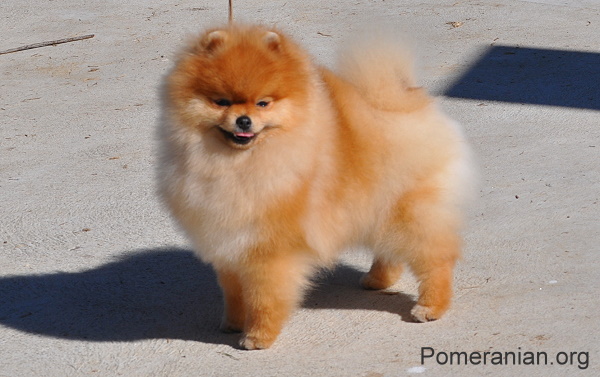
Can a Collapsed Trachea Heal Itself?
A Pomeranian collapsed trachea can’t be cured. This is one reason why medical management should be tried before considering surgical intervention which carries a lot of risks and should only be carried out by an experienced surgeon.
71% of dogs receiving treatment show a vast improvement in symptoms. If your dog is in distress and you attend the vet office in an emergency, they need to first stabilize the dog.
He’s usually placed in an oxygen cage to help with breathing. The vet often needs to inject a fast-acting steroid to decrease the inflamed larynx and trachea. Cough suppressants may be given and sedation may help, too.
If the vet has prescribed medication and it hasn’t helped for two weeks, your dog may require surgery to solve the problem.
The most effective procedure right now is applying prosthetic polypropylene rings that go around the trachea.
This helps in 75%-85% of cases and is more successful in younger dogs. Your dog needs follow-up care that’s a mix of vet care and your own care. This is essential as it will quickly alert you if your Pomeranian isn’t getting better.
In Summer, keep your home well-ventilated because heat makes it harder for your pet to breathe properly if he has a collapsed trachea.
Surgery is usually the last resort because there are lots of things that can go wrong. There’s a 10% chance of paralysis of the larynx due to degenerated nerves involved in regular breathing.
Stents can be used. These are tiny metal cylinders that are inserted into the trachea that keep it open. However, long-term issues may arise.
Stents may move around, there may be too much granulation of tissue, a stent can fracture and a few other issues may occur.
Some surgeons prefer to use stents if the dog’s trachea has collapsed in the chest, not the throat, because the throat collapsing mean the dogs aren’t ideal candidates for anaesthetic as the mortality rate is much higher. Dogs who have either rings or stents inserted generally live another 2 – 2.5 years on average.
Tracheostomies

There’s a 20% chance of a permanent tracheotomy (half of the cases occur within the first 24 hours) causing a major problem. However, if your dog gets through it, there will be very few long-term issues.
A tracheostomy is another way to help your dog breathe again. The surgeon cuts a small opening in the dog’s windpipe to let air in and to eliminate secretions. There are two types of this procedure.
Temporary Tracheostomy
In an emergency a temporary tracheostomy can be used if your dog can’t breathe through the larynx, nose or mouth. This is an upper respiratory obstruction and the aim is to get him breathing again quickly.
The dog can’t get enough air into his lungs. This may also be carried out if surgical procedures are underway that relate to the tissues around the dog’s mouth A small incision is made into the skin above the trachea and then pierces the trachea itself.
A small plastic breathing tube is then inserted into the opening and immediately lets your dog breathe. This tube hinders his ability to clear debris and mucous and so it can easily and rapidly become blocked. The tube needs regular cleaning and close monitoring to stop this from happening.
The dog will be kept in the hospital and closely supervised in case of discharge or infection. Once he can breathe through his upper airways on his own, the tube is finally removed and the opening will seal within a day or two.
However, part of the skin’s incision is left open so the trachea can heal before the skin does. It stops air from leaking out and getting trapped under the skin. After two weeks, the cut should be healed.
Permanent Tracheostomy
A permanent tracheostomy is carried out when there’s a severe obstruction in the dog’s upper airway and it can’t be treated by medicine or surgery. For example, a tumour or a collapsed larynx can’t be removed surgically.
Instead of a hole being cut, a window is cut instead. The edges are then sutured to the adjacent skin and the result is a large permanent opening. The animal breathes through the new opening without any need for a tube.
Permanent Tracheostomy Dog Care
Your Pom needs long term care after such a procedure. The site needs to be monitored closely in case debris and mucous build up at its opening. Keep the hair around the entrance as short as possible so it doesn’t obstruct the airflow.
Your pet can’t swim while this hole is open. When you wash him, you can’t allow water to get in. Use a harness-style collar instead of a neck collar. If you notice the entrance is shrinking, take your dog to the vet to check it out.
A smaller entrance can reduce the airflow and the vet may need to surgically widen it again. A tracheostomy is just a method for helping your pet breathe better.
The initial problem still exists. It may continue to deteriorate over time and cause more problems for your dog.
Indicators That Necessitate a Tracheostomy
If your dog can’t breathe due to a problem with his upper airway, this procedure should be considered. Neck or facial trauma, throat cancer, a collapsing trachea or foreign objects stuck in the throat are also indicators that this procedure is needed to ease or fix the problem.
A tube may be inserted after upper airway surgery if there’s a risk of swelling which may reduce the size of the airway. This procedure allows intermittent or continuous access to the dog’s lower airway so secretions can be removed.
This is vital if the dog is being treated for various forms of pneumonia or smoke inhalation. The tube also helps air get into the lungs. This is crucial in cases of carbon monoxide poisoning, smoke inhalation, and acute respiratory distress.
What Tests are Required Prior to a Tracheostomy?
Tests will vary according to the age and overall health of the dog and also for the reason for the procedure. No tests are needed if it’s carried out to prevent the dog from dying because he can’t breathe.
If the reason is cancer, major trauma, or problems with the dog’s trachea, lots of tests may be done. They include a urinalysis, blood count, x-rays, serum biochemical tests, and maybe an EKG.
What Type of Anaesthesia is Used For a Tracheostomy?
If it’s an emergency, the tracheostomy can be carried out with no anaesthetic or a very fast-acting one. In the case of non-emergency scenarios, a general anaesthetic is preferred so the dog is completely asleep.
They’ll give him a pre-anaesthetic analgesic-sedative drug to make him relax and then some anaesthesia to let them insert the breathing tube into his windpipe. Then, as the procedure goes on, inhalation gas and oxygen are used.
How is The Tracheostomy Actually Carried Out?
The dog will be placed on his back on the table. The hair on the underside of his neck will be clipped as short as possible. Then the skin will be scrubbed with surgical soap so the area is completely disinfected.
A sterile drape is spread over the area that will be cut. The surgeon will use a sharp scalpel to cut the skin, being very careful not to touch the thyroid gland which is in the neck. Surrounding muscles and tissues are dissected so the trachea can be isolated.
Once it’s exposed, part of one ring is removed. This makes an opening into the trachea. The tube is then inserted through the incision and secured with umbilical tape. For a permanent tracheostomy, the edges of the opening are sutured to the skin so the hole stays open permanently.
Sometimes absorbable stitches are used and they’ll simply dissolve over time. Other times, there are non-absorbable stitches used and they need to be taken out in 10-14 days. Now your beloved dog can breathe via the tube instead of using his mouth and nose.
Temporary tracheostomies are usually carried out if a dog has swallowed something he shouldn’t or if there’s a lot of swelling in the larynx. After the problem is fixed, the tube can be taken out and the incision will start healing.
How Long Does This Take?
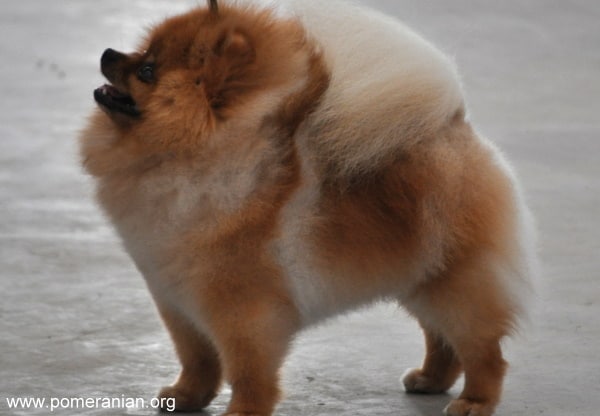
The procedure can take from 15-45 minutes depending on if it’s an emergency scenario or something that’s permanent. There are cases where it will take longer and two surgeons may be needed.
Risks and Complications of a Tracheostomy?
The overall risk associated with this procedure is moderate. The reason for performing it is that the pet can’t breathe properly. When that’s the case, his life is at risk.
Major risks are related to general anaesthetic, difficulty breathing, pneumonia, infection and bleeding. Future scarring may occur. The overall rate of complications is low but serious complications may require further surgery or may even cause the death of the patient.
Typical Post-Operative Care?
It’s common for the Pomeranian dog to be given pain relief, which is usually mild to moderate. You must ensure your pet remains calm and much less active than usual until the stitches are taken out.
Avoid allowing him to scratch or rub the site which has to be cleaned daily until it finally heals. Check for signs of swelling or redness.
With a temporary procedure, your pet won’t have the tube still in place but he’ll have the opening that, in time, will heal over. He’ll be able to breathe properly again. If he has bad coughing bouts or trouble breathing, contact the vet urgently.
How Long Will Your Dog Remain in Hospital After the Procedure?
Your pet will stay for about 2-3 days but this can vary according to how well the procedure went. He obviously won’t be released until the surgeon is happy with his progress.
Disclaimer: The Content is not intended to be a substitute for professional veterinarian advice, diagnosis, or treatment. Always seek the advice of your veterinarian with any questions you may have regarding the medical condition of your dog. Never disregard professional advice or delay in seeking it because of something you have read on ANY website.
N.B. This article regarding Pomeranian health issues was written in consultation with our resident veterinarian.
Dr. Muqeet Mushtaq
DVM, University of Animal and Veterinary Sciences, 2019
MSc. (Hons.) (Animal Breeding & Genetics), University of Agriculture Faisalabad, 2021
Copyright Pomeranian.org. All Rights Reserved.
References and Further Reading:
[1] Denise Leo “The Pomeranian Handbook”.
